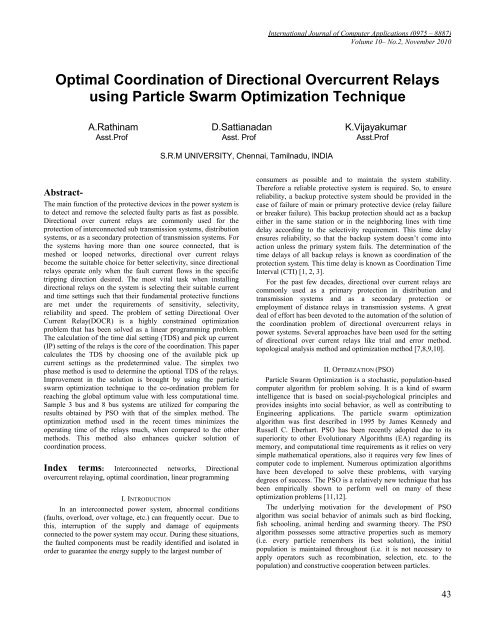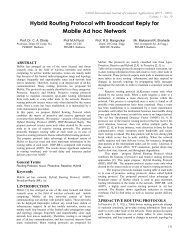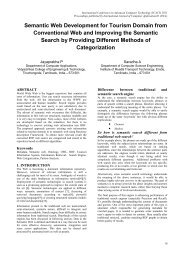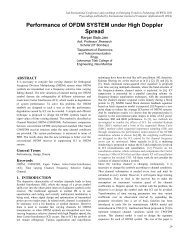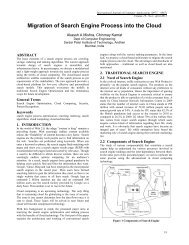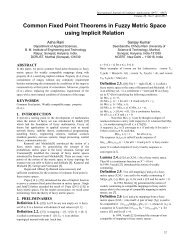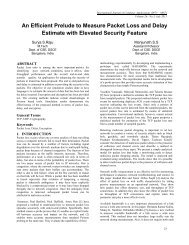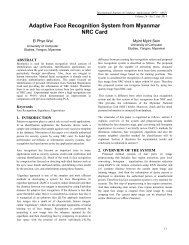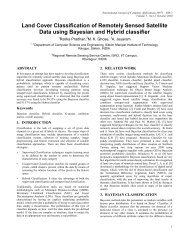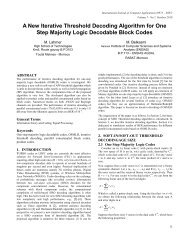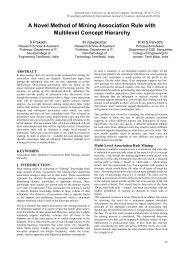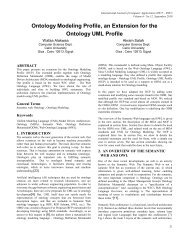Optimal Coordination of Directional Overcurrent Relays using ...
Optimal Coordination of Directional Overcurrent Relays using ...
Optimal Coordination of Directional Overcurrent Relays using ...
You also want an ePaper? Increase the reach of your titles
YUMPU automatically turns print PDFs into web optimized ePapers that Google loves.
International Journal <strong>of</strong> Computer Applications (0975 – 8887)<br />
Volume 10– No.2, November 2010<br />
<strong>Optimal</strong> <strong>Coordination</strong> <strong>of</strong> <strong>Directional</strong> <strong>Overcurrent</strong> <strong>Relays</strong><br />
<strong>using</strong> Particle Swarm Optimization Technique<br />
A.Rathinam D.Sattianadan K.Vijayakumar<br />
Asst.Pr<strong>of</strong> Asst. Pr<strong>of</strong> Asst.Pr<strong>of</strong><br />
S.R.M UNIVERSITY, Chennai, Tamilnadu, INDIA<br />
Abstract-<br />
The main function <strong>of</strong> the protective devices in the power system is<br />
to detect and remove the selected faulty parts as fast as possible.<br />
<strong>Directional</strong> over current relays are commonly used for the<br />
protection <strong>of</strong> interconnected sub transmission systems, distribution<br />
systems, or as a secondary protection <strong>of</strong> transmission systems. For<br />
the systems having more than one source connected, that is<br />
meshed or looped networks, directional over current relays<br />
become the suitable choice for better selectivity, since directional<br />
relays operate only when the fault current flows in the specific<br />
tripping direction desired. The most vital task when installing<br />
directional relays on the system is selecting their suitable current<br />
and time settings such that their fundamental protective functions<br />
are met under the requirements <strong>of</strong> sensitivity, selectivity,<br />
reliability and speed. The problem <strong>of</strong> setting <strong>Directional</strong> Over<br />
Current Relay(DOCR) is a highly constrained optimization<br />
problem that has been solved as a linear programming problem.<br />
The calculation <strong>of</strong> the time dial setting (TDS) and pick up current<br />
(IP) setting <strong>of</strong> the relays is the core <strong>of</strong> the coordination. This paper<br />
calculates the TDS by choosing one <strong>of</strong> the available pick up<br />
current settings as the predetermined value. The simplex two<br />
phase method is used to determine the optional TDS <strong>of</strong> the relays.<br />
Improvement in the solution is brought by <strong>using</strong> the particle<br />
swarm optimization technique to the co-ordination problem for<br />
reaching the global optimum value with less computational time.<br />
Sample 3 bus and 8 bus systems are utilized for comparing the<br />
results obtained by PSO with that <strong>of</strong> the simplex method. The<br />
optimization method used in the recent times minimizes the<br />
operating time <strong>of</strong> the relays much, when compared to the other<br />
methods. This method also enhances quicker solution <strong>of</strong><br />
coordination process.<br />
Index terms: Interconnected networks, <strong>Directional</strong><br />
overcurrent relaying, optimal coordination, linear programming<br />
I. INTRODUCTION<br />
In an interconnected power system, abnormal conditions<br />
(faults, overload, over voltage, etc.) can frequently occur. Due to<br />
this, interruption <strong>of</strong> the supply and damage <strong>of</strong> equipments<br />
connected to the power system may occur. During these situations,<br />
the faulted components must be readily identified and isolated in<br />
order to guarantee the energy supply to the largest number <strong>of</strong><br />
consumers as possible and to maintain the system stability.<br />
Therefore a reliable protective system is required. So, to ensure<br />
reliability, a backup protective system should be provided in the<br />
case <strong>of</strong> failure <strong>of</strong> main or primary protective device (relay failure<br />
or breaker failure). This backup protection should act as a backup<br />
either in the same station or in the neighboring lines with time<br />
delay according to the selectivity requirement. This time delay<br />
ensures reliability, so that the backup system doesn’t come into<br />
action unless the primary system fails. The determination <strong>of</strong> the<br />
time delays <strong>of</strong> all backup relays is known as coordination <strong>of</strong> the<br />
protection system. This time delay is known as <strong>Coordination</strong> Time<br />
Interval (CTI) [1, 2, 3].<br />
For the past few decades, directional over current relays are<br />
commonly used as a primary protection in distribution and<br />
transmission systems and as a secondary protection or<br />
employment <strong>of</strong> distance relays in transmission systems. A great<br />
deal <strong>of</strong> effort has been devoted to the automation <strong>of</strong> the solution <strong>of</strong><br />
the coordination problem <strong>of</strong> directional overcurrent relays in<br />
power systems. Several approaches have been used for the setting<br />
<strong>of</strong> directional over current relays like trial and error method.<br />
topological analysis method and optimization method [7,8,9,10].<br />
II. OPTIMIZATION (PSO)<br />
Particle Swarm Optimization is a stochastic, population-based<br />
computer algorithm for problem solving. It is a kind <strong>of</strong> swarm<br />
intelligence that is based on social-psychological principles and<br />
provides insights into social behavior, as well as contributing to<br />
Engineering applications. The particle swarm optimization<br />
algorithm was first described in 1995 by James Kennedy and<br />
Russell C. Eberhart. PSO has been recently adopted due to its<br />
superiority to other Evolutionary Algorithms (EA) regarding its<br />
memory, and computational time requirements as it relies on very<br />
simple mathematical operations, also it requires very few lines <strong>of</strong><br />
computer code to implement. Numerous optimization algorithms<br />
have been developed to solve these problems, with varying<br />
degrees <strong>of</strong> success. The PSO is a relatively new technique that has<br />
been empirically shown to perform well on many <strong>of</strong> these<br />
optimization problems [11,12].<br />
The underlying motivation for the development <strong>of</strong> PSO<br />
algorithm was social behavior <strong>of</strong> animals such as bird flocking,<br />
fish schooling, animal herding and swarming theory. The PSO<br />
algorithm possesses some attractive properties such as memory<br />
(i.e. every particle remembers its best solution), the initial<br />
population is maintained throughout (i.e. it is not necessary to<br />
apply operators such as recombination, selection, etc. to the<br />
population) and constructive cooperation between particles.<br />
43
International Journal <strong>of</strong> Computer Applications (0975 – 8887)<br />
Volume 10– No.2, November 2010<br />
In this paper, the problem <strong>of</strong> coordinating directional over<br />
current relays in power systems is stated and solved in the<br />
framework <strong>of</strong> optimization theory. The proposed approach<br />
determines the "optimal" solution to this coordination problem in a<br />
cost effective and efficient way, by stating the problem as a<br />
parameter optimization problem, and solving it <strong>using</strong> efficient<br />
optimization techniques. Here the optimization <strong>of</strong> Time Dial<br />
Setting and minimized function got from Linear programming<br />
with Large-Scale: Interior Point in Matlab has been done by<br />
Particle swarm Optimization technique coded in C#. It is pertinent<br />
to mention here that the Optimization methodology presented in<br />
this paper can also be applied to the problem <strong>of</strong> optimal<br />
coordination <strong>of</strong> protective relays other than directional over<br />
current relays (e.g. distance relays [9]). The optimization approach<br />
and its particularization to the case <strong>of</strong> directional over current<br />
relays are presented below<br />
III. DOCR OPTIMAL COORDINATION PROBLEM<br />
DOCR coordination problem is a parametric optimization<br />
problem, where different constraints have to be considered in<br />
solving the objective function. Here the objective function to be<br />
minimized is the sum <strong>of</strong> the operating times <strong>of</strong> the relays<br />
connected to the system, subject to the following constraints.<br />
A. Relay Characteristics:<br />
A typical inverse time directional overcurrent relay has two<br />
units, an instantaneous unit(time independent) and an inverse<br />
overcurrent unit (time dependent). The time dependent unit has<br />
two values to be set, the pickup current (Ip) and the time dial<br />
setting (TDS). The pickup value is the minimum value <strong>of</strong> current<br />
for which the relay operates. The time dial setting defines the<br />
operating time (T) <strong>of</strong> the relay for each current value. The<br />
characteristics <strong>of</strong> the OCR are given as a curve <strong>of</strong> T versus M,<br />
where, i.e.<br />
M = I/I P (1)<br />
Where I is the relay current (overload/fault current). M is a<br />
multiple <strong>of</strong> the pickup current and I P is the pickup current.<br />
Here the overcurrent relay is conformed to the following IEC<br />
characteristic [6,10]. The following formula is used to<br />
approximately represent the inverse overcurrent relay<br />
characteristics.<br />
T = k 1 .TDS/ (M k2 -1) (2)<br />
Where k 1 and k 2 are constants that depend on the relay<br />
characteristics.<br />
The relation between the operating time (T) <strong>of</strong> the time<br />
overcurrent unit and the multiple <strong>of</strong> pickup current (M), is<br />
nonlinear. The multiple <strong>of</strong> pickup current <strong>of</strong> the relays can be<br />
predetermined and so for a fixed M, the above equation can be rewritten<br />
as<br />
T = a . TDS<br />
(3)<br />
Where<br />
a<br />
1<br />
=<br />
k2<br />
M<br />
K<br />
−1<br />
B. Relay Settings:<br />
The calculation <strong>of</strong> the two settings, TDS and Ip, is the essence<br />
<strong>of</strong> the directional <strong>Overcurrent</strong> relay coordination study. It is very<br />
important to mention that in general, directional overcurrent relays<br />
allow for continuous time dial settings but discrete (rather than<br />
continuous) pickup current settings.<br />
Therefore this constraint can be formulated as:<br />
TDS<br />
i<br />
≤ TDS<br />
i<br />
≤ TDS<br />
min i max<br />
I pi min ≤ I pi ≤ I pi max<br />
C. <strong>Coordination</strong> Formulation:<br />
In any power system, a primary protection has its own backup<br />
one for guaranteeing a dependable power system. The two<br />
protective systems (primary and back-up) should be coordinated<br />
together. <strong>Coordination</strong> time interval (CTI) is the criteria to be<br />
considered for coordination. It’s a predefined coordination time<br />
interval and it depends on the type <strong>of</strong> relays. For electromagnetic<br />
relays, CTI is <strong>of</strong> the order <strong>of</strong> 0.3 to 0.4 s, while for a<br />
microprocessor based relay, it is <strong>of</strong> the order <strong>of</strong> 0.1 to 0.2 s.<br />
To ensure reliability <strong>of</strong> the protective system, the back-up<br />
scheme shouldn’t come into action unless the primary (main) fails<br />
to take the appropriate action. Only when CTI is exceeded, backup<br />
relay should come into action.<br />
This case is expressed as<br />
T<br />
backup<br />
Where<br />
− T<br />
primary<br />
≥ CTI<br />
T<br />
backup<br />
is the operating time <strong>of</strong> the backup relay.<br />
T<br />
primary<br />
is the operating time <strong>of</strong> the primary relay.<br />
After considering all these criteria, this problem can be<br />
formulated mathematically as<br />
min<br />
n<br />
∑ i = 1<br />
a i<br />
. TDS<br />
Where i=1 to n, n represents the number <strong>of</strong> relays.<br />
i<br />
IV. ALOGRITHAM OF PSO<br />
PSO1: Initialize positions and associated velocity <strong>of</strong> all<br />
particles (potential solutions) in the population randomly in the D<br />
dimension space.<br />
PS02: Evaluate the fitness value <strong>of</strong> all particles.<br />
PS03: Compare the PBEST <strong>of</strong> every particle with its current<br />
fitness value. If the current fitness value is better, then assign the<br />
current fitness value to PBEST.<br />
PS04: Determine the current best fitness value in the whole<br />
population. If the current best fitness value is better than the<br />
GBEST, then assign the current best fitness value to GBEST .<br />
PS05: Change velocities <strong>using</strong> t8he following equation:<br />
V(t+1) id = w × vi(t) + c1 × rand() × (pbestid − S(t)id ) + c2 ×<br />
Rand() × (gbestd – S(t)id) (4)<br />
Where<br />
i=1, 2---- n; d=1, 2--- m.<br />
‘n’ is the population size,<br />
‘m’ is the number <strong>of</strong> units and<br />
the ‘w’ value is set <strong>using</strong>:<br />
w = wmax – ((wmax – wmin) / itermax) × iter<br />
44
International Journal <strong>of</strong> Computer Applications (0975 – 8887)<br />
Volume 10– No.2, November 2010<br />
where, wmax = 0.9; wmin = 0.4.<br />
c1 and c2 are two positive constants<br />
rand()are random function in the range [0,1].<br />
Using the above equation, a certain velocity, which gradually<br />
gets close to pbest and gbest, can be calculated. The current<br />
position can be modified by the following equation:<br />
S(t+1)id = S(t)id + V(t+1)id (5)<br />
PS06: Move each particle to S(t)id + V(t+1)id<br />
PS07: Repeat steps PSO2-PSO6 until a stop criterion is<br />
satisfied OR a pre specified number <strong>of</strong> iterations is completed<br />
A. Three Bus System:<br />
The system under study is a 3 bus system as shown in Fig.1.<br />
Identical directional overcurrent relays with inverse characteristics<br />
have been used in these examples, so that k1=0.14, k2= 0.02.<br />
B. Eight Bus System:<br />
In this section the proposed method will be illustrated <strong>using</strong><br />
the 8-bus, 9-branch network, taken from and shown in figure 3.<br />
This figure also specifies the location <strong>of</strong> directional<br />
overcurrent relays. The above algorithms can also be implemented<br />
<strong>using</strong> the Microcontrollers <strong>using</strong> the relevant hardware circuits.<br />
Fig 2. Effect <strong>of</strong> particle on convergence<br />
TABLE I<br />
COMPARISION OF RELAY OPERATING TIME BY LPP AND PSO<br />
TECHNIQUE FOR 3 BUS SYSTEMS<br />
USING LPP<br />
USING PSO<br />
1.6908 s 1.3233 s<br />
Fig 1. Three Bus System<br />
Fig 3. Eight Bus System.<br />
45
International Journal <strong>of</strong> Computer Applications (0975 – 8887)<br />
Volume 10– No.2, November 2010<br />
TABLE 2<br />
COMPARISION OF RELAY OPERATING TIME BY LPP AND PSO<br />
TECHNIQUE FOR 8BUS SYSTEMS<br />
USING LPP<br />
USING PSO<br />
17.1518 s 13.097 s<br />
Fig 4. Effect <strong>of</strong> particle on convergence<br />
In the above figures 3 and 4, the convergence<br />
characteristics <strong>of</strong> PSO for the varied number <strong>of</strong> particles and the<br />
learning index – a constant which is used in MPSO algorithm is<br />
given. It is provided to prove the convergence ability <strong>of</strong> the<br />
MPSO.<br />
V. CONCLUSION<br />
In this paper, an optimization methodology is presented to<br />
solve the problem <strong>of</strong> coordinating directional overcurrent relays in<br />
an interconnected power system. The operating time <strong>of</strong> the relay<br />
was determined <strong>using</strong> MATLAB and is found to be 1.6908s for<br />
Three bus system and 17.1518s for Eight bus system. This value is<br />
further optimized <strong>using</strong> Modified Particle Swarm Optimization<br />
technique in C#. A Linear Programming problem formulation was<br />
presented in this project for the optimal coordination <strong>of</strong><br />
<strong>Directional</strong> Over Current <strong>Relays</strong>. It is found that MPSO requires<br />
only five particles for the optimization <strong>of</strong> the objective function.<br />
Therefore the proposed algorithm was used to obtain the optimal<br />
setting <strong>of</strong> the operation time <strong>of</strong> the directional over current relays<br />
in the two case study system, a 3-bus system and an 8-bus system.<br />
The operating time values are found to be 1.3233s for three bus<br />
system and 13.097s for eight bus System. On studying these two<br />
cases and comparing the results with those obtained from<br />
MATLAB, it is seen that the objective function <strong>of</strong> the DOCR relay<br />
is minimized.<br />
The optimization <strong>of</strong> the coordination <strong>of</strong> <strong>Directional</strong> over<br />
current relays can be further improved by considering or<br />
formulating new coordination constraints. Further, by improving<br />
the existing features <strong>of</strong> MPSO like updating PSO technique, the<br />
optimization <strong>of</strong> relay coordination can be improved.<br />
VI. REFERENCES<br />
[1] P.M. Anderson, Power system Protection. Newyork:<br />
McGraw-Hill, 1999.<br />
[2] Warrington, ARC, The Protective <strong>Relays</strong>. Theory and<br />
Practice, John Wiley 8 Sons, New York, 1969.<br />
[3] Westinghouse Electric Corp., Applied Protective Relaying,<br />
Westinghouse Electric Corp., Newark, NJ. 1979.<br />
[4] General Electric Co. Measurements, Protective <strong>Relays</strong><br />
Application Guide, GEC, United Kingdom, 1975.<br />
[5] A. J. Urdenta, et al. “<strong>Optimal</strong> <strong>Coordination</strong> <strong>of</strong> <strong>Directional</strong><br />
Over current <strong>Relays</strong> in Interconnected Power Systems”, IEEE<br />
Trans. on Power Delivery, Vol. 3, July 1988, pp. 903-911.<br />
[6] Quanming Yue, Feipeng Lu, Weiyong Yu, and Jie Wang<br />
“A Novel Algorithm to Determine Minimum Break Point Set for<br />
Optimum Cooperation <strong>of</strong> <strong>Directional</strong> Protection <strong>Relays</strong> in<br />
Multiloop Networks” IEEE Transactions on power delivery, Vol.<br />
21, pp.1114-1119,July2006<br />
[7] N. A. Laway, H. O. Gubta, “A Method for <strong>Coordination</strong> <strong>of</strong><br />
Over current <strong>Relays</strong> in an Interconnected Power Systems”, IE<br />
Journal, Vol. 74,August1993,pp.59-65..<br />
[8] Urdaneta, AJ.”Minimax Optimization for Power System<br />
Control: A Multiple Objective Approach,” PhD Dissertation, Case<br />
Western Reserve University,<br />
[9] IEC Standard, Single Input Energizing Quantity Measuring<br />
<strong>Relays</strong> with Dependent Specified Time, Publication No. 255-4,<br />
1976.<br />
[10] C.W.So, K.K.Li “Application <strong>of</strong> genetic algorithm for<br />
overcurrent relay coordination”, IEE 6 th international conference<br />
on development in power system protection, Nottingham, UK,<br />
March 1997, pp 66-69<br />
[11] B.Chattopadhyay, M.S.Sachedev and T.S.Sidhu,”An On<br />
Line relay <strong>Coordination</strong> Algorithm for Adaptive protection <strong>using</strong><br />
Linear Programming Techniuqe”, IEEE Transaction on power<br />
Delivery, Vol. 11, No.1, January 1996, pp.165-173<br />
[12] J.Kennedy and R. Eberhart, “Particle swarm optimization”<br />
in Proc. IEEE Neural Networks Conf.Piscataway, NJ, 1995, pp<br />
1942-1948<br />
[13] Y.Shi and R.Eberhart,” A modified particle swarm<br />
optimizer” in Proc IEEE Int.Conf, on Evolutionary Computation,<br />
1998, pp 69-73<br />
46
International Journal <strong>of</strong> Computer Applications (0975 – 8887)<br />
Volume 10– No.2, November 2010<br />
VII. BIOGRAPHIES:<br />
A. Rathinam currently holds the position <strong>of</strong> Assistant Pr<strong>of</strong>essor<br />
<strong>of</strong> the EEE Department at the SRM University, Chennai, India.<br />
He received his Bachelor <strong>of</strong> Engineering degree from the Faculty<br />
<strong>of</strong> Engineering and Technology, Annamalai University, India and<br />
Master <strong>of</strong> Engineering from the same university in the year 1996<br />
in Power Systems Engineering. He is currently pursing his PhD<br />
degree in SRM University in the area <strong>of</strong> Multidimensional Digital<br />
Signal Processing. He has 4 International Journals and 23 papers<br />
in International Conferences which includes conferences<br />
Sponsored by both IEEE and IET. He has been awarded Best<br />
teacher award in the department for the academic year 2005. His<br />
area <strong>of</strong> research interests includes Computational Intelligence<br />
applications in Power systems and Analog integrated circuits,<br />
Digital Signal Processing, Electrical Machines, Microprocessors<br />
and Microcontrollers.<br />
K. Vijayakumar currently holds the position <strong>of</strong> Assistant<br />
Pr<strong>of</strong>essor <strong>of</strong> the EEE Department at the SRM University, Chennai,<br />
India. He received his Bachelor <strong>of</strong> Engineering degree from the<br />
Faculty <strong>of</strong> Engineering and Technology, Annamalai University,<br />
India, Master <strong>of</strong> Engineering from the same university in the year<br />
1996 in Power Systems Engineering. He is currently pursing his<br />
Ph.D degree in Anna University in the area <strong>of</strong> Deregulation<br />
systems.He has published 4 international journals and 15<br />
international Conferences. His area <strong>of</strong> research interests includes<br />
Computational Intelligence applications in Power Systems,<br />
FACTS and Power System Operation and Control. He has been<br />
awarded Best teacher award in the department for the academic<br />
year 2004 &2006.<br />
D. Sattianadan received the Bachelor <strong>of</strong> Engineering in Electrical<br />
and Electronics Engineering from Madras University in the year<br />
2000 and Master <strong>of</strong> Engineering in Power systems from Anna<br />
University in the year 2005. He is currently working as Assistant<br />
pr<strong>of</strong>essor in the Department <strong>of</strong> Electrical and Electronics<br />
Engineering, SRM University, Chennai, India. His area <strong>of</strong> interest<br />
includes Power System Operation and Control, FACTS and Power<br />
System Protection. Also, he is working towards his doctoral<br />
degree in the area <strong>of</strong> Distributed Generations in Distributed<br />
Systems.<br />
47


